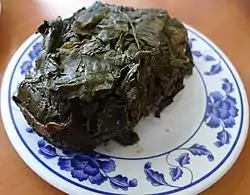Laulau
Laulau, otherwise known as Lū in Tonga, Palusami in Fiji and Samoa and Rukau in the Cook Islands, is a Polynesian dish consisting of cooked taro leaves containing fillings such as pork, fish or coconut cream. In old Hawaiʻi, laulau was assembled by taking a few leaves and placing a few pieces of fish and pork in the center. In modern times, the dish uses taro leaves, salted butterfish, and either pork, beef, or chicken and is usually steamed on the stove. Laulau is a typical plate lunch dish and is usually served with a side of rice and macaroni salad.[1]
 Traditional laulau | |
| Alternative names | Lū, Pulasami, Rukau |
|---|---|
| Place of origin | Polynesia, Fiji |
| Region or state | Cook Islands, Hawaii, Samoa, Tonga |
| Main ingredients | Taro leaves |
In the classical preparation, the ends of the luau leaf are folded and wrapped again in the leaf. When ready, all the laulau is placed in an underground oven, called an imu. Hot rocks are placed on the dish and covered in banana leaves and buried again. A few hours later the laulau is ready to eat.
References
- Alan D. McNarie. "Bundles of Joy". Hana Hou!, June/July 2017, Vol. 20, No. 3. Retrieved November 4, 2017.
- Laudan, Rachel (1996). The Food of Paradise: Exploring Hawaii's Culinary Heritage. Seattle: University of Hawaiʻi Press. ISBN 0-8248-1778-8. Archived from the original on 2016-08-22. Retrieved 2020-02-23.
External links
- Kam, Nadine. "Honolulu Star-Bulletin Features". starbulletin.com. Retrieved 2008-06-16.